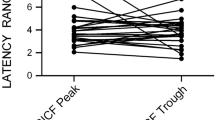Summary
Different physiological mechanisms of facilitation of latencies and amplitudes of magnetic motor evoked potentials (MEPs) were evaluated in a cohort of 140 healthy volunteers. The potentials were induced at the vertex and recorded at the abductor pollicis brevis. The aim of the present investigation was to compare physiological mechanisms which presumably facilitate motor pathways at the cortical level with those known to occur during contraction of small hand muscles. When compared with MEPs at rest, the maximum average decrease of latencies (1.5, SD 1.1 ms) as well as the highest increase of peak to peak amplitudes (2.6, SD 2.1 mV) was observed during exertion of a voluntary background force, at the muscle recorded from. Pre-innervation of a neighbouring muscle (abductor digiti minimi) led to a lesser average decrease of latencies by 1.0, SD 1.1 ms and an average increase of amplitudes by only 0.5, SD 1.5 mV. Non-specific manoeuvres, like sticking out the tongue or counting aloud, reduced mean latencies slightly by 0.4 ms, SD 0.8 ms and 0.3 SD 0.85 ms respectively, but increased amplitudes markedly by an average of 1.0, SD 1.6 mV and 0.8, SD 1.4mV respectively. It is concluded that facilitation of MEPs by non-specific manoeuvres occurs and must be taken into account when evaluating MEPs.
Similar content being viewed by others
References
Agnew WF, McCreery DB (1987) Considerations for safety in the use of extracranial stimulation for the motor evoked potentials. Neurosurgery 20:143–147
Amassian VE, Stewart M, Quirk GJ (1987) Physiological basis of motor effects of transient stimulus to cerebral cortex. Neurosurgery 20:74–93
Barker AT, Freeston IL, Jalinous R, Merton PA, Morton HB (1985) Magnetic stimulation of the human brain. J Physiol (Lond) 369:3P
Barker AT, Freeston IL, Jalinous R, Jarrat JA (1987) Magnetic stimulation of the human brain and peripheral nervous system: an introduction and the results of an initial clinical evaluation. Neurosurgery 20:100–109
Berardelli A, Cowan JMA, Day BL (1985) The site of facilitation of the response to cortical stimulation during voluntary contraction in man. J Physiol (Lond) 360:52P
Bickford RG, Guidi M, Fortesque P, Swenson M (1987) Magnetic stimulation of human peripheral nerve and brain: response enhancement by combined magnetoelectrical technique. Neurosurgery 20:110–116
Buchman AS, Eisen AA, Hoirch M (1988) Facilitation of cortical motor evoked potentials: evidence for spinal contributions. Muscle Nerve 9:994–995
Claus D, Mills KR, Murray MF (1988) Facilitation of muscle responses to magnetic brain stimulation by mechanical stimuli in man. Exp Brain Res 71:273–278
Cracco RQ (1987) Evaluation of conduction in central motor pathways: techniques, pathophysiology and clinical interpretation. Neurosurgery 20:199–203
Day BL, Thompson PD, Dick J, Nakashima K, Marsden CD (1987) Different sites of action of electrical and magnetic stimulation of the human brain. Neurosci Lett 75:101–106
Deletis V, Dimitrijevic MR, Sherwood AM (1987) Effects of electrically induced afferent input from limb nerves on the excitability of the human cortex. Neurosurgery 20:195–197
Helmers SL, Chiappa KH, Didier C, Gupta N, Santamaria I (1989) Magnetic stimulation of the human cortex: facilitation and its relationship to a visual motor task. J Clin Neurophysiol 4:321–331
Hess CW, Mills KR, Murray NMF (1986) Magnetic stimulation of the human brain: facilitation of motor responses by voluntary contraction of ipsilateral and contralateral muscles with additional observations on an amputee. Neurosci Lett 71:235–240
Hess CW, Mills KR, Murray NMF (1987) Responses in small hand muscles from magnetic stimulation of the human brain. J Physiol (Lond) 388:397–419
Hess CW, Mills KR, Murray NMF (1988) Methodological considerations for magnetic brain stimulation. In: Barber C, Blum T (eds) Evoked potentials III. The Third International Evoked Potential Symposium. Butterworths, London, pp 456–461
Hufnagel A, Elger CE, Durwen HF, Böker DK, Entzian W (1990) Activation of the epileptic focus by transcranial magnetic stimulation of the human brain. Ann Neurol 27:49–60
Levy WJ (1987) Transcranial stimulation of the motor cortex to produce motor-evoked potentials. Med Instrum 21:248–254
Ludolph AC, Wenning G, Masur H, Füratsch N, Elger CE (1989) Die elektromagnetische Stimulation des Nervensystems. I. Normwerte im zentralen Nervensystem und Vergleich mit der elektrischen Stimulation. Z EEG-EMG 20:153–158
Michelucci R, Rubboli G, Plasmati R (1989) Transcranial magnetic stimulation of the cerebral cortex in epilepsy. Neurology 39, Suppl 1:414
Mills KR (1988) Excitatory and inhibitory effects on human spinal motoneurons from magnetic brain stimulation. Neurosci Lett 94:297–302
Mills KR, Murray NMF, Hess CW (1987) Magnetic and electrical transcranial brain stimulation: physiological mechanisms and clinical applications. Neurosurgery 20:164–168
Rossini PM, Caramia MD, Zarola F (1987) Mechanisms of nervous propagation along central motor pathways: noninvasive evaluation in healthy subjects and in patients with neurological disease. Neurosurgery 20:183–191
Rossini PM, Zarola F, Stalberg E (1988) Pre-movement facilitation of motor-evoked potentials in man during transcranial stimulation of the central motor pathways. Brain Res 458:20–30
Rothwell JC, Day BL, Thompson PD, Dick JPR, Marsden CD (1987) Some experiences of techniques for stimulation of the human cerebral motor cortex through the scalp. Neurosurgery 20:156–163
York DH (1987) Review of descending motor pathways involved with transcranial stimulation. Neurosurger 20:70–73
Young RR, Cracco RQ (1985) Clinical neurophysiology of conduction in central motor pathways. Ann Neurol 18:606–610
Author information
Authors and Affiliations
Rights and permissions
About this article
Cite this article
Hufnagel, A., Jaeger, M. & Elger, C.E. Transcranial magnetic stimulation: specific and non-specific facilitation of magnetic motor evoked potentials. J Neurol 237, 416–419 (1990). https://doi.org/10.1007/BF00314732
Received:
Revised:
Accepted:
Issue Date:
DOI: https://doi.org/10.1007/BF00314732




